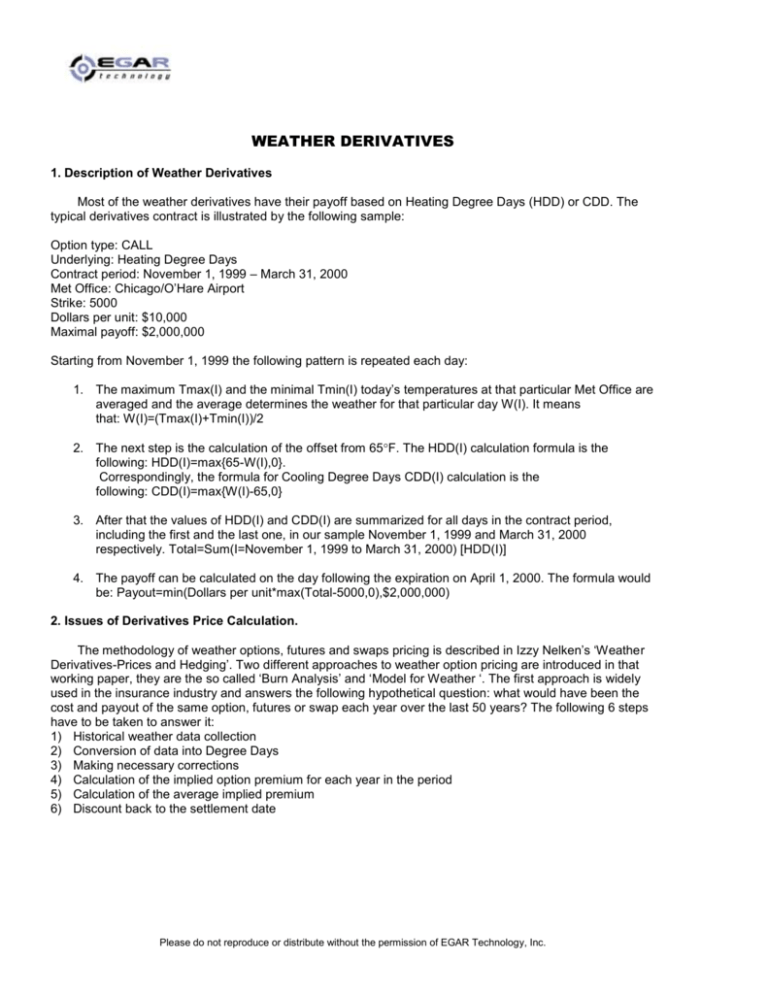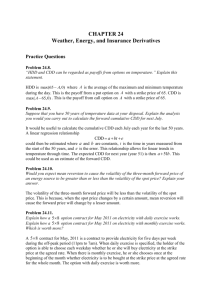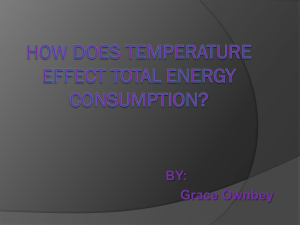Weather Derivatives
advertisement

WEATHER DERIVATIVES
1. Description of Weather Derivatives
Most of the weather derivatives have their payoff based on Heating Degree Days (HDD) or CDD. The
typical derivatives contract is illustrated by the following sample:
Option type: CALL
Underlying: Heating Degree Days
Contract period: November 1, 1999 – March 31, 2000
Met Office: Chicago/O’Hare Airport
Strike: 5000
Dollars per unit: $10,000
Maximal payoff: $2,000,000
Starting from November 1, 1999 the following pattern is repeated each day:
1. The maximum Tmax(I) and the minimal Tmin(I) today’s temperatures at that particular Met Office are
averaged and the average determines the weather for that particular day W(I). It means
that: W(I)=(Tmax(I)+Tmin(I))/2
2. The next step is the calculation of the offset from 65F. The HDD(I) calculation formula is the
following: HDD(I)=max{65-W(I),0}.
Correspondingly, the formula for Cooling Degree Days CDD(I) calculation is the
following: CDD(I)=max{W(I)-65,0}
3. After that the values of HDD(I) and CDD(I) are summarized for all days in the contract period,
including the first and the last one, in our sample November 1, 1999 and March 31, 2000
respectively. Total=Sum(I=November 1, 1999 to March 31, 2000) [HDD(I)]
4. The payoff can be calculated on the day following the expiration on April 1, 2000. The formula would
be: Payout=min(Dollars per unit*max(Total-5000,0),$2,000,000)
2. Issues of Derivatives Price Calculation.
The methodology of weather options, futures and swaps pricing is described in Izzy Nelken’s ‘Weather
Derivatives-Prices and Hedging’. Two different approaches to weather option pricing are introduced in that
working paper, they are the so called ‘Burn Analysis’ and ‘Model for Weather ‘. The first approach is widely
used in the insurance industry and answers the following hypothetical question: what would have been the
cost and payout of the same option, futures or swap each year over the last 50 years? The following 6 steps
have to be taken to answer it:
1) Historical weather data collection
2) Conversion of data into Degree Days
3) Making necessary corrections
4) Calculation of the implied option premium for each year in the period
5) Calculation of the average implied premium
6) Discount back to the settlement date
Please do not reproduce or distribute without the permission of EGAR Technology, Inc.
The second approach is based on direct weather modeling and consists of 7 steps:
1)
2)
3)
4)
5)
6)
7)
Historical weather data collection
Making necessary corrections
Creation of a statistical weather model
Forecasting the weather in the future using the model
Calculation of the implied premium for each calculated weather data sample
Calculation of the average implied premium
Discount back to the settlement date
The shortcoming of the first approach is the lack of any analytical formulas that could significantly
increase the potentialities of the analysis. The main concern for using the second approach is the 3rd step,
indeed, the meteorologists are trying to work out an adequate long-term statistical model of weather for
many years and, from what we know, this goal has not been achieved so far.
In our calculations we are using a hybrid approach, which is devoid of the above-mentioned
shortcomings and our step-by-step algorithm looks as follows:
1)
2)
3)
4)
Historical weather data collection
Conversion of data into Degree Days
Calculation of HDD and CDD statistics for given periods
Selection of analytical distribution function of HDD and CDD, using open statistical methods of
distribution function feed
5) Creation of a pricing formula for options, futures and swaps pricing for a selected analytical distribution
function of HDD and CDD (like Black-Sholes formula for log-normal distribution)
6) Calculation of the price of the derivative using Monte-Carlo method, flexibly accounting for the nuances
of the statistical distribution.
3. Simple Option Pricing
The simple methods of weather derivatives pricing can be achieved by using probability distribution feed
from historical monthly HDD or CDD levels, and integration of the probability level multiplied by option’s
payoff. The expected payoff of CDD Call option or its theoretical value would be the following:
rd *t
Pr Dpu * e
CDD max
(CDD Str) * P(CDD)dCDD
Str
Where:
Pr- expected payoff of CDD option;
Dpu- Dollars per unit;
rd- rate of interest;
t –time to expiration;
Str-strike;
CDDmax= Maximal payout/ Dpu+Str;
P(CDD)- frequency function.
The calculation of option’s fair price requires collection of historical data of daily temperatures and use of
statistical methods of feeding the distribution function from this data. In many cases the distribution functions
of CDD and HDD can be approximated using normal Gauss distribution. In such cases, the frequency
function depends on the two main factors: the average value of mu and the standard deviation of sigma, and
can be calculated using the following formula:
Please do not reproduce or distribute without the permission of EGAR Technology, Inc.
1
GS ( x)
e
2
P(CDD)
1
2
( x)
2
1
CDD mu
GS (
)
sigma
sigma
For Gauss distribution, the expected payoff of a CDD Call option will be the following:
CDD max mu
sigma
Strike mu
ustrike
sigma
u max
rd *t
Pr Dpu * e
( sigma * (GS (ustrike) GS (u max)) (mu Strike) * ( Lp (u max) Lp (ustrike)))
u
Lp (u ) Gs( x)dx
Generally, the expected payoff of CDD (HDD) Call (Put) options is a function with the following parameters:
tstart(period start date),tend(period end date),rd,Dpu,MaxPay, Strike ,mu,sigma, IsCall and can be
calculated as below:
If IsCall=1(Call) then
theta=1
a=Strike
b= MaxPay/ Dpu+ Strike
If IsCall=0(Put) then
theta=-1
a=Strike- MaxPay/ Dpu
b= Strike
ub=(b-mu)/sigma
uf=(a-mu)/sigma
PrCP=Dpu*exp(-rd*(tend-tstart))*theta*(sigma*(GS(ub)- GS(ua))+(mu-Strike)*(Lp(ub)- Lp(ua))
4. Retieval of Function’s Inputs
The determinative factor for the above-mentioned option pricing method is the retrieval of the relevant
levels of average and standard deviation.Which time sample should we choose to assess the parameters?
Should we use last 10 years or 20 or even 50? The problem is that the climate is not stationary and the
requisite values of average and standard deviation change with time. Castlebridge LLC usually takes 10
years for average and 30 years for standard deviations. In any case, the inputs for the function are the
annual levels of CDD (HDD) for the period from tstart to tend.
5. Monte Carlo Method
If daily CDD (HDD) statistics is taken as benchmark data, then it is possible to use Monte-Carlo method
for calculation of CDD (HDD) payoff. Provisionally, the average of daily values of mudays(I) and standard
deviations of sigmadays(I) of CDD (HDD) for each given period are calculated, where I=1,2,…D; D-number
of days in period. If we make an assumption that the daily parameters have Gauss distribution and all
Please do not reproduce or distribute without the permission of EGAR Technology, Inc.
observations are independent, then we can model the process of CDD (HDD) fluctiation N times (~1000),
calculate the fair option price for each level, and compute the fair option value by averaging the results. The
assumption about the independence of observation can be waived if the covariance matrix of temperature
distribution by days is calculated and used to generate random vectors for CDD(HDD)(I) in the above
calculations.
6. Excel Functions For Weather Derivatives Pricing
The two methods of weather option and futures price calculation described above are displayed in
C:\MARK\weatherder.xls. There are 11 functions that serve this purpose:
1. PriceBasket - this function calculates the price of a futures or basket option for nstn Met Stations using
the end formula, derived under condition that CDD (HDD) are normally distributed. In case of nstn=1 the
function simply calculates the price of an option or a futures.
2. PriceMCBasket - the function returns the price of a futures or a basket option for nstn Met Stations
using Monte-Carlo method. In case of nstn=1 the function simply calculates the price of an option or a
futures.
3. PriceFut - the function calculates the futures’ price for one Met Station using the end formula, derived
under condition that CDD (HDD) are normally distributed.
4. PriceOpt - the function returns the option’s price for one Met Station using the end formula, derived
under condition that CDD (HDD) are normally distributed and known distribution factors (expected value
and dispersion)
5. PriceMCFut - the function calculates the futures’ price for one Met Station using Monte-Carlo method
with known distribution factors (expected value and dispersion) and normal distribution of CDD (HDD).
6. PriceMCOpt - the function returns the option’s price for one Met Station using Monte-Carlo method with
known distribution factors (expected value and dispersion) and normal distribution of CDD (HDD).
7. CorrStn - this subroutine calculates the correlation matrix for the Met Stations that form the basket.
8. StatDailyCovNew - this subroutine calculates the expected value and dispersion of CDD (HDD)
distribution for each day of observation and the sum of CDD (HDD) parameters for all days.
9. Normval - this function returns the Gauss random value with given expected value and dispersion.
10. Lp - the function calculates the value of Laplace function.
11. Nordis - the function calculates the density function of normal (Gauss) distribution
Please do not reproduce or distribute without the permission of EGAR Technology, Inc.









